ABSTRACT
This study examined the effects of reading comprehension deficits on the learning success of Grade 11 Humanities and Social Sciences (HUMSS) students. Conducted using a descriptive research design, the study focused on how these impairments influence students' academic performance, motivation, and engagement in their studies. The research involved 183 respondents, selected with a confidence level of 95% and a margin of error of 5%.
Findings revealed that reading comprehension challenges significantly impact students' ability to grasp complex materials, leading to decreased motivation and engagement. These deficits also contribute to lower academic performance, particularly in subjects requiring critical analysis and understanding. The study emphasized the need for targeted interventions to address these issues, ensuring that students develop the necessary skills to succeed academically and personally.
Moreover, the researchers recommended that schools implement programs to enhance reading comprehension skills among HUMSS students. These could include workshops, mentorship initiatives, and tailored instructional approaches to improve literacy and critical thinking. Schools should also provide comprehensive support systems, such as counseling and additional resources, to assist students struggling with reading comprehension. Furthermore, educators should align teaching strategies with students’ individual needs to foster an inclusive and supportive learning environment.
The conclusions underscore the importance of addressing reading comprehension deficits to ensure equitable academic success and holistic development for all learners.
Chapter 1
THE PROBLEM AND ITS BACKGROUND
Introduction
Reading comprehension is a critical skill that directly influences student’s academic success, particularly in fields like Humanities and Social Sciences that rely heavily on text-based learning. Deficits in this area can significantly hinder students' ability to grasp complex concepts, leading to broader challenges in their overall educational development.
According to Landi and Ryherd (2017), reading comprehension deficits, especially those linked to specific reading comprehension deficit (S-RCD), happened in children and adolescents who have trouble understanding what they read, even though they can read words and have normal intelligence. This disorder involves small weaknesses in various skills needed for understanding, like understanding word meanings, making inferences, and keeping track of what they read. While there is not a clear agreement on what causes S-RCD, it is thought to have a connection to how the brain works, and more research is needed to find early signs of the disorder and better understand how the brain is involved.
In addition, Cain and Oakhill (2007) explored how working memory, inference generation, and understanding of story structure contribute to reading comprehension difficulties. They found that children with specific reading comprehension deficits often struggle with these cognitive processes, which are crucial for constructing coherent representations of text. Moreover, their research highlighted that these difficulties are not solely due to limited vocabulary or poor decoding skills but are related to deeper cognitive processing challenges. The findings suggest the importance of targeted interventions that address these underlying cognitive deficits to improve reading comprehension outcomes.
Researchers at Nasugbu East Senior High School want to evaluate how reading comprehension deficits affect the learning success of Grade 11 Humanities and Social Science students. They also aim to gather feedback to create educational programs that will address these challenges and improve student outcomes.
Background of the Study
Research has shown that reading comprehension is a critical skill for EFL learners, as it directly impacts their ability to understand and engage with English texts. The challenges in reading comprehension are often rooted in factors such as limited vocabulary, difficulties in recognizing and processing words, and the complexity of the language itself. These issues can hinder learners' ability to grasp the overall meaning and context of the texts they encounter. Studies have indicated that these challenges are not only widespread but also consistent across different learner demographics.
Hezam et al. (2022) found that EFL learners in the University of Bisha, KSA, struggle significantly with vocabulary recognition and comprehension, regardless of gender. This suggests that reading comprehension difficulties are a universal problem among EFL learners, necessitating targeted interventions to enhance their proficiency in reading and understanding English.
However, even though students work hard to improve their reading comprehension, some challenges still remain. Zuhra (2015) found that while some students have improved their vocabulary and understanding of sentence structures, these improvements were not enough to overcome the difficulties they faced with inference questions. The study suggests that even with more reading practice, the skill of making inferences is still a major challenge. This is because inference questions need a deeper level of thinking and understanding, which many students struggle with due to gaps in their vocabulary and grammar. So, while practice and exposure can help, without focused teaching on inference skills, students may continue to find this area difficult, as Zuhra (2015) pointed out.
In lieu thereof, the researchers utilized the descriptive research design to evaluate the Effect of Reading Comprehension on the Learning Success faced by Humanities and Social Sciences Student at Nasugbu East Senior High School. The findings served as the basis for the development of targeted interventions aimed at enhancing reading comprehension among HUMSS students, contributing to a more comprehensive understanding of the issues and potential solutions.
Statement of the Problem
The study aimed to evaluate the Effects of Reading Comprehension Deficits on Learning Success of the Humanities and Social Sciences Student at Nasugbu East Senior Highschool, Brgy. Lumbangan, Nasugbu, Batangas, Academic Year 2024 – 2025.
Specifically, the study sought answers to the following question:
1. How the reading comprehension deficits influence the academic performance of SHS students across different subjects?
2. How the reading comprehension deficits affect the motivation and engagement levels of SHS students in their studies?
3. What interventions are most effective in improving reading comprehension skills and overall learning success in SHS students?
Scope and Limitations of the Study
The study is focused on Evaluating the Effects of Reading Comprehension Deficits on the Learning Success of Humanities and Social Sciences Student at Nasugbu East Senior High School, Barangay Lumbangan, Nasugbu, Batangas.
The study is limited to HUMSS students from the aforementioned school. Data were collected exclusively through survey questionnaires answered by the respondents. The findings serve as the basis for proposing educational interventions aimed at enhancing reading comprehension skills, thereby improving overall learning outcomes for the students.
Definition of Terms
Reading Comprehension. It refers to the cognitive and constructive process of understanding and interpreting text, which involves both conceptually driven (top-down) and data-driven (bottom-up) processes. This process integrates text-based information with prior knowledge through inferential thinking to construct a mental model of the text (Woolley, 2011). In this study, reading comprehension refers to the ability of Grade 11 Humanities and Social Science (HUMSS) students to understand, interpret, and engage with the texts they read, particularly in academic materials.
Specific Reading Comprehension Deficit (S-RCD). It refers to a condition where individuals, despite adequate word-level reading ability and intellectual capacity, struggle with understanding and interpreting text due to deficits in comprehension subskills, such as semantic processing, inference making, and comprehension monitoring (Landi & Ryherd, 2017). S-RCD is defined as the difficulty experienced by some students in understanding written content, despite having the ability to decode words and possessing normal cognitive functions, as observed in the HUMSS students.
Inference Generation. It refers to the process of drawing conclusions or making connections between text and prior knowledge to maintain coherence during reading, with differences in comprehension skills affecting the type and use of knowledge-based inferences made in response to textual information (Carlson et al., 2014).This term refers to the ability of students to make logical conclusions and predictions based on the information provided in a text, which is measured by their performance in comprehension assessments.
Working Memory. It refers to a cognitive system directed by the central executive, responsible for the temporary storage and manipulation of information necessary for tasks such as reasoning and learning. The central executive controls attention, managing both automatic, habit-based tasks and tasks that require focused or divided attention (Baddeley, 2020). In the context of this study, working memory is the capacity of HUMSS students to hold and manipulate information while reading texts, which impacts their comprehension and learning success.
English as a Foreign Language (EFL). It refers to the experience of learning and using English in a non-native context, where learners develop skills in reading, understanding, organizing, and translating information, often impacted by linguistic and cultural factors. EFL students apply various strategies to navigate the complexities of language in their acquisition of information literacy (Johnston et al., 2014). In this study, EFL (English as a Foreign Language) refers to the context in which students at Nasugbu East Senior High School are learning English as a second language, affecting their reading comprehension and academic performance.
Academic Performance. It refers to a student's success in achieving educational goals, which is influenced by both academic and social motivational factors, including beliefs about ability, efficacy, achievement values, and goal orientations. Contextual factors, such as teachers' instructional practices and interpersonal relationships, also play a significant role in shaping student motivation and academic outcomes (Wentzel & Wigfield, 1998). In this study, academic performance refers to the grades and learning outcomes of Grade 12 Humanities and Social Sciences students, as measured by their ability to comprehend and apply what they read in their coursework.
Targeted Interventions. It refers to specific educational strategies designed to address particular learning challenges by providing tailored support, such as literacy coaching for teachers, to improve outcomes for struggling students. These interventions focus on diagnosing and addressing individual student needs to enhance their reading and academic skills (Vernon-Feagans et al., 2012).In this study, targeted interventions refer to the specific teaching strategies and support programs developed based on the research findings to improve reading comprehension and address the deficits identified in HUMSS students.
Vocabulary Recognition. It refers to the ability to quickly and accurately identify and recall words, which serves as a predictive measure of academic performance in English-medium instruction contexts. This skill is assessed through tools like the Timed Yes/No (TYN) test, which evaluates the relationship between word recognition and language proficiency in university settings (Roche et al., 2016).Vocabulary recognition refers to the students' ability to identify and understand individual words in a text, which directly influences their reading comprehension performance in the study.
Text-based learning. Text- based learning also known as text-based instruction (TBI), is an approach that utilizes written texts, usually delivered through text messages, to provide educational content and facilitate learning. Text-based learning as an essential component of their learning delivery methods.(Gragg, 2023).In this study, text-based learning refers to the educational activities where HUMSS students are required to read and comprehend textual materials as a primary method of acquiring knowledge.
Educational Programs. These refer to structured learning initiatives, particularly in correctional settings, aimed at providing basic, postsecondary, and vocational education to offenders. These programs are designed to improve participants' skills, reduce recidivism, and increase future employment opportunities. However, challenges such as security restrictions and limited classroom time can impact their effectiveness (MacKenzie, 2008).Educational programs are the intervention strategies designed by the researchers based on the findings of this study, aimed at addressing reading comprehension deficits among HUMSS students.
Chapter 2
REVIEW OF RELATED LITERATURE
This chapter presents an intensive review of related literatures found to be relevant to the present study. This chapter likewise includes the conceptual and theoretical frameworks, and research similacrum.
Influence of Reading Comprehension Deficits on the Academic Performance of the SHS students in various subjects
According to Akurah (2020), reading difficulties among students can be attributed to several factors including poor reading speed, negative attitudes of teachers, and ineffective teaching approaches.
In addition, Appiah's (2020) study on Huni-Valley Senior High School highlights that reading comprehension challenges are not solely due to poor teaching methods but also involve overcrowded classrooms and inadequate support from parents.
Similarly, Nippold (2017) emphasizes that underlying language deficits, including deficiencies in word reading, lexical, and syntactic development, contribute significantly to poor reading comprehension.
Lesaux and Kieffer (2010) further expand on this by exploring reading comprehension difficulties among language minority learners and native English speakers. Their study shows that both groups struggle with comprehension due to low vocabulary knowledge, although language minority learners face additional challenges.
Finally, Bibon and Barcenas (2022) explore the impact of study habits on academic performance. They found that study habits like reviewing lessons and taking notes have a low correlation with academic success, indicating that reading comprehension and study habits are interlinked but not solely responsible for academic performance.
Effects of Reading Comprehension Deficits on Motivation and Engagement levels of SHS students
Reading comprehension is a critical skill that significantly influences students' academic performance, motivation, and engagement. According to Ahmadi (2017), motivation plays a vital role in language learning, particularly in reading comprehension, as students who are more motivated tend to engage better with reading tasks, leading to improved comprehension skills.
Similarly, Mehigan (2020) found that fluency-oriented reading instruction (FORI) positively impacted struggling readers' motivation, self-efficacy, and orientation towards reading, suggesting that students who perceive reading as challenging may experience decreased motivation and engagement.
Additionally, Takaloo and Ahmadi (2017) emphasize that learners' motivation, particularly intrinsic motivation, has a direct relationship with reading comprehension, which further impacts students' academic success and classroom participation.
This is consistent with findings by Manansala and Jimenez (2020), who observed that senior high school students with higher intrinsic motivation demonstrated better comprehension skills, while extrinsic motivation had a weaker correlation.
Lastly, the study by Eldawo and Abdelrahim (2020) highlights that insufficient motivation and poor reading strategies can lead to lower comprehension levels, thus decreasing students’ overall engagement in academic activities.
Theoretical Framework
According to Bartlett's Schema Theory (1932), pre-existing cognitive structures known as schemas shape human memory and understanding. Schemas are mental frameworks that organize and interpret information, allowing people to process new information by connecting it to prior knowledge. According to Bartlett, comprehension is an active process in which readers or listeners use their pre-existing schemas to make sense of new information. These schemas emerge from experience and influence how we perceive, interpret, and remember texts and events
In terms of reading comprehension, schema theory emphasizes the significance of a reader's prior knowledge in comprehending a text. When people encounter a new passage, they don't interpret it in isolation. Instead, they apply the new information to their existing schemas. This mapping enables readers to fill in gaps, infer meaning, and comprehend implied or unstated information in the text. For example, if a reader is familiar with the concept of a "wedding," their schema for this event may include information about the ceremony, attire, and social significance, allowing them to better understand a wedding-related narrative even if some details are absent
However, schema theory highlights potential limitations in comprehension. Misunderstanding or confusion may occur if the reader's existing schema is incomplete or does not match the content of the text. Furthermore, individuals may impose their schemas too rigidly, resulting in distorted memories or interpretations. For example, when confronted with information that contradicts their prior knowledge, readers may unconsciously alter or ignore portions of the text to fit their existing schema. As a result, while schemas aid comprehension by organizing new information, they can also bias or limit understanding if they are inflexible or inaccurate.
Conceptual Framework
This framework aims to explore how reading comprehension deficits impact the learning success of students in the humanities and social sciences. Reading comprehension is essential for understanding complex texts, critical analysis, and synthesis of ideas—skills vital in these fields.
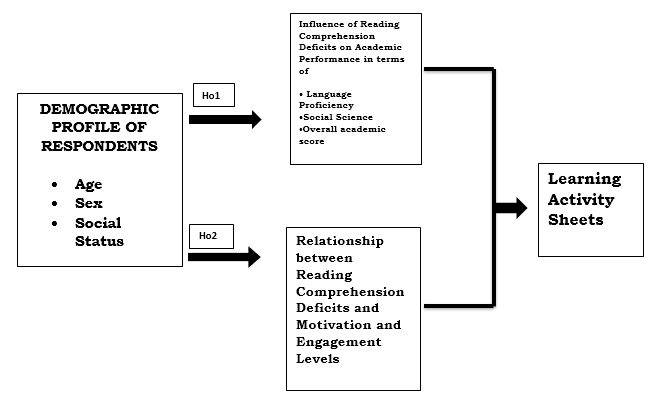
Chapter 3
RESEARCH METHODS AND PROCEDURES
This chapter presents the research design, the locale of the study, the respondents, the construction and validation of the research instrument, ethical considerations, data-gathering procedures, and the statistical treatment of data.
Research Design
The study used a descriptive research design to evaluate how reading comprehension deficits affect the learning success of Grade 11 Humanities and Social Sciences (HUMSS) students. Based on McCombes.(2019) Descriptive research aims to accurately and systematically describe a population, situation or phenomenon. In this study, the method was utilized to gather data on how reading comprehension deficits influence students' academic performance, motivation, and engagement across various subjects. This design helped identify patterns and relationships between reading comprehension skills and learning outcomes.
Locale of the Study
The study was conducted at Nasugbu East Senior High School, located in Barangay Lumbangan, Nasugbu, Batangas. The school was established in 2016 and is currently headed by a Principal II. It employs fifty- one(51) teachers and ten (10) non-teaching staff, serving a total population of 639 students across Grades 11 and 12. For School Year 2023-2024, the Humanities and Social Sciences (HUMSS) strand has a total enrollment of 337 students. The school offers a range of academic tracks, including Accountancy, Business and Management (ABM), HUMSS, Science, Technology, Engineering, and Mathematics (STEM), and Technical-Vocational-Livelihood (TVL).
Respondents of the Study
The sample size for the study was calculated using Slovin’s Formula, which is used to determine an appropriate sample size for a given population with a specified margin of error. Based on a population of 337 HUMSS students, the sample size was determined to be 183 respondents, with a confidence level of 95% and a margin of error of 5%. Simple Random Sampling (SRS) was employed to select the respondents, ensuring that every student in the population had an equal chance of being chosen. This method was used to avoid selection bias and to ensure that the sample accurately represents the population.
Research Instrument
The researcher developed a survey questionnaire to gather data on reading comprehension deficits and their effects on academic performance, motivation, and engagement. The instrument was structured into two parts:
Part I: The demographic profile of the respondents, including age, gender, and socio-economic status.
Part II: A Likert-scale questionnaire measuring reading comprehension deficits and their influence on academic performance and motivation, with a scale of 1-4 (1-Strongly Disagree to 4-Strongly Agree).
Construction and Validation of the Instrument
The research instrument was created with the guidance of the thesis adviser and reviewed by education experts to ensure that it accurately measured the variables under investigation. Feedback from the experts helped refine the questionnaire to improve its clarity, validity, and reliability. This process ensured that the survey questions were aligned with the study's objectives and could generate accurate and meaningful data.
Ethical Considerations
Ethical principles were strictly followed throughout the study. The researcher obtained informed consent from all respondents before collecting data, ensuring that participation was voluntary. Each participant was provided with an explanation of the study's purpose, and they were assured that their responses would remain confidential and anonymous. Respondents were also informed of their right to withdraw from the study at any point without any consequences. The researcher ensured that the dignity and privacy of the respondents were protected at all times.
Data Gathering Procedure
Before the data collection, the researcher sought and received permission from the principal of Nasugbu East Senior High School and the district supervisor. After securing approval, the researcher distributed the questionnaires to the selected respondents. A brief explanation of the study's objectives was provided before the survey to clarify any doubts or questions. The respondents were given sufficient time to complete the questionnaire, and the researcher ensured that all responses were collected and checked for completeness.
Statistical Treatment of Data
The following statistical tools were used to analyze the data collected: 1. Frequency and Percentage: Used to describe the demographic profile of the respondents, including age, gender, and socio-economic status, as well as to express the relative frequency of responses.
2. Weighted Mean and Standard Deviation: Applied to assess the extent of reading comprehension deficits and their effects on students' academic performance and motivation.
3. Weighted Mean and Standard Deviation: Also used to evaluate the effectiveness of interventions aimed at improving reading comprehension and learning success.
Chapter 4
PRESENTATION, ANALYSIS, AND INTERPRETATION OF DATA
This part presents the data gathered, analyses and interpretation to answer the problem which this study aims to achieve.
1.Influence of Reading Comprehension Deficits on Academic Performance of Senior High School Students Across Different Subjects
Table 1 highlights the respondents' challenges with reading comprehension and its influence on their academic performance. The highest Weighted Mean is 2.60 (SD = 2.24), indicating that respondents struggle to follow along with complex reading materials in subjects outside of English. This is qualitatively described as Agree, reflecting Akurah's (2020) observation that reading difficulties can stem from factors such as poor reading speed and ineffective teaching approaches. Similarly, Lesaux and Kieffer (2010) identified vocabulary knowledge as a significant contributor to reading comprehension challenges, particularly in academic settings involving diverse subject matter.
The lowest Weighted Mean is 2.37 (SD = 2.03), which pertains to respondents disagreeing that they fail to complete assignments on time due to reading challenges. This suggests that while reading comprehension deficits exist, they do not directly impede students' ability to meet deadlines.
The overall Grand Weighted Mean is 2.49 (SD = 2.11), described as Disagree, indicating that respondents generally do not perceive reading comprehension issues as significantly hindering their academic performance. This finding is consistent with Bibon and Barcenas' (2022) study, which suggests that reading comprehension and academic performance are interlinked but not solely determinant of academic success.
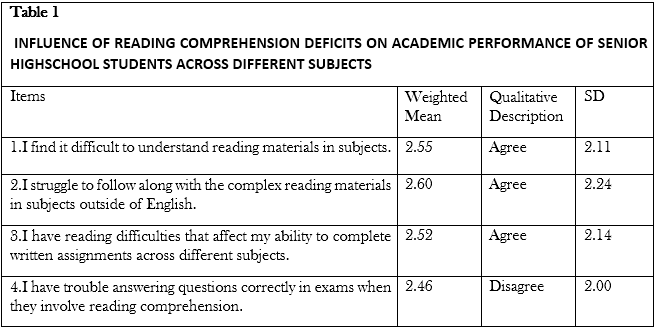
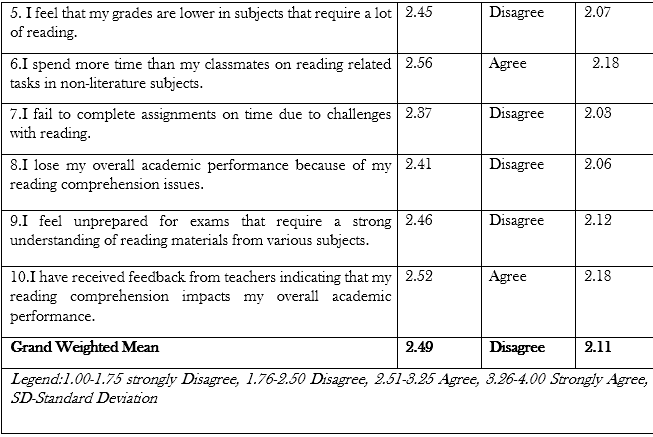
2. Impact of Reading Comprehension Deficits on Students' Motivation and Engagement in Studies
Table 2 illustrates the respondents' perspectives on how reading comprehension deficits affect their motivation and engagement in academic activities. The highest Weighted Mean is 2.75 (SD = 2.32), which pertains to respondents feeling discouraged when they receive low grades on reading assignments. This result is qualitatively described as Agree, suggesting that students' struggles with reading comprehension directly impact their self-confidence and motivation.
Conversely, the lowest Weighted Mean is 2.18 (SD = 2.64), indicating that respondents Disagree with the statement that they feel overwhelmed by the reading requirements of their courses. This implies that while reading comprehension challenges exist, they do not lead to a pervasive sense of being overwhelmed.
The overall Grand Weighted Mean is 2.85 (SD = 2.48), which falls under the qualitative description of Disagree. This indicates that, on average, respondents perceive that their reading comprehension difficulties do not significantly affect their motivation and engagement. However, the findings emphasize specific areas, such as discouragement from low grades and seeking help, where students demonstrate the impact of their struggles. These findings align with Ahmadi's (2017) assertion that motivation is a vital factor in reading comprehension, as well as Mehigan's (2020) findings that FORI can help struggling readers improve their engagement.
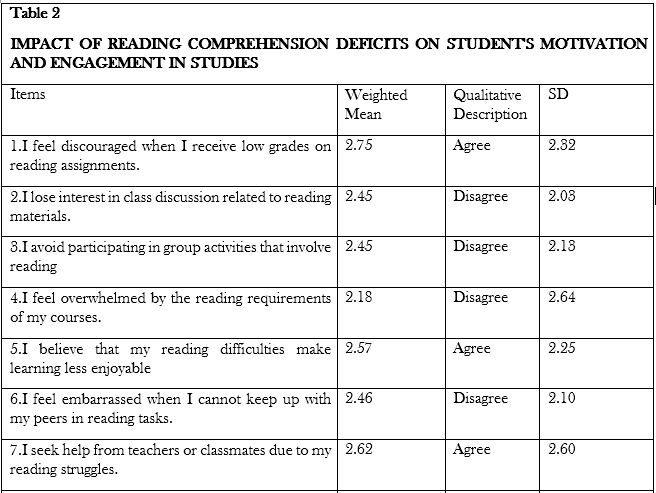
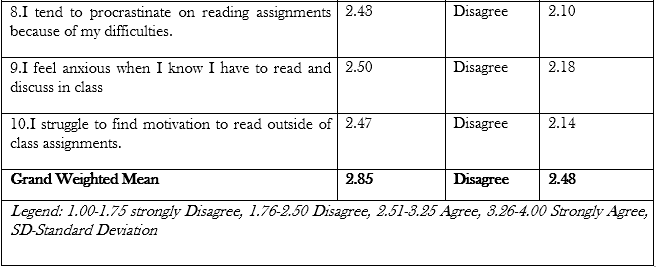
Chapter 5
SUMMARY, CONCLUSION AND RECOMMENDATION
This chapter presents the summary of findings, conclusions, and recommendations of the study.
SUMMARY OF FINDINGS
1. Influence of Reading Comprehension Deficits on Academic Performance of Senior High School Students Across Different Subjects
The study revealed that respondents generally disagreed with the notion that reading comprehension deficits significantly hinder their academic performance, with a Grand Weighted Mean of 2.49 (SD = 2.11). While some aspects, such as struggling with complex reading materials in non-English subjects (WM = 2.60, SD = 2.24), were acknowledged, other areas, such as the ability to meet deadlines despite reading challenges (WM = 2.37, SD = 2.03), were not significantly impacted.
2. Impact of Reading Comprehension Deficits on Students' Motivation and Engagement in Studies
The findings indicated that respondents disagreed that their reading comprehension challenges greatly affect their motivation and engagement, with a Grand Weighted Mean of 2.85 (SD = 2.48). However, specific instances, such as feeling discouraged by low grades on reading assignments (WM = 2.75, SD = 2.32), reflected the struggles students face. Despite these challenges, the data suggested that respondents do not experience an overwhelming loss of motivation or engagement overall.
CONCLUSIONS
Based on the findings of the study, the following conclusions are drawn:
1. Respondents generally perceive that reading comprehension deficits do not have a significant impact on their overall academic performance across different subjects.
2. While reading comprehension issues slightly affect motivation and engagement, respondents do not view these challenges as pervasive or entirely detrimental to their academic experiences.
3. The specific areas where students feel the impact of reading comprehension difficulties—such as discouragement from low grades—highlight the need for targeted support in these aspects.
RECOMMENDATIONS
In light of the findings and conclusions, the following recommendations are proposed:
1. For Teachers:
- Incorporate targeted reading comprehension activities into the curriculum, especially for non-literature subjects, to address areas where students face difficulties.
- Provide timely and constructive feedback on reading assignments to help students identify areas of improvement and build self-confidence.
2. For Students:
Actively seek help from teachers or peers when struggling with reading comprehension.
Engage in self-study strategies, such as vocabulary building and practice reading materials across diverse subjects, to strengthen comprehension skills.
3. For School Administrators:
- Offer professional development programs for teachers focusing on effective strategies to enhance reading comprehension among students.
- Create a supportive learning environment by implementing school-wide programs that promote the importance of reading skills in all subject areas.
4. For Future Researchers:
- Conduct further studies to explore the long-term effects of reading comprehension deficits on academic success.
- Investigate the role of socio-economic factors and their relationship to students' reading comprehension challenges and motivation levels.
BIBLIOGRAPHY
Allan Baddeley (2020). "Working Memory" https://www.taylorfrancis.com/chapters/edit/10.4324/9780429449642-4/working-memory-alan-baddeley
Andrew D Manansala and Jessica J Jimenez (2020). "Motivation and Comprehension in Reading of Senior High School Students" https://www.paressu.org/online/index.php/aseanjbh/article/view/231
Appiah M.V (2020). "Reading comprehension challenges among students of Huni – valley senior high school" http://ir.uew.edu.gh:8080/handle/123456789/4309
Bartlett's Schema Theory (1932) “https://education.stateuniversity.com/pages/2175/Learning-Theory-SCHEMA-THEORY.html?fbclid=IwZXh0bgNhZW0CMTAAAR01IatBlnMQLyWL6j9vJeoYbtH2vnSVoknDxGBPUf9ep0LtZBk-UdYhits_aem_8i_sh42xX6k_NCt5GCLruA
Doris Layton MacKenzie (2008). “Structure and Components of Successful Educational Programs” http://johnjay.jjay.cuny.edu/files/DorisMackenzie_Final.pdf
Garry Wooley (2011). "Reading Comprehension: Assisting Children with Learning Difficulties" https://link.springer.com/chapter/10.1007/978-94-007-1174-7_2
Gene Mehigan (2020). "Effects of Fluency Oriented Instruction on Motivation for Reading of Struggling Readers" https://ouci.dntb.gov.ua/en/works/4vwLVbel/
Jay Mar Barcenas and Michael Bibon (2022). "The Influence of Study Habits in the Academic Performance of Senior Highschool Students in Cagraray Island Philippines" https://www.researchgate.net/profile/Michael-Bibon/publication/358571971_The_Influence_of_Study_Habits_in_the_Academic_Performance_of_Senior_High_School_Students_in_Cagraray_Island_Philippines/links/6208f2a27b05f82592e70c41/The-Influence-of-Study-Habits-in-the-Academic-Performance-of-Senior-High-School-Students-in-Cagraray-Island-Philippines.pdf
Kate Cain & Jane Oakill (2007). “Reading Comprehension Difficulties: Correlates, Causes, and Consequences” https://psycnet.apa/record/2007-05218-002
Kathryn R Wentzel, Allan Wigfield (1998). "Academic and social motivational influences on students' academic performance "https://link.springer.com/article/10.1023/a:1022137619834
Kate Cain & Jane Oakill (2007). “Reading Comprehension Difficulties: Correlates, Causes, and Consequences” https://psycnet.apa/record/2007-05218-002
Lynne Vernon-Feagans, Kirsten Kainz, Steve Amendum, Marnie Ginsberg, Tim Wood, Amanda Bock (2012). "Targeted reading intervention: A coaching model to help classroom teachers with struggling readers" https://journals.sagepub.com/doi/abs/10.1177/0731948711434048
Mohammad Reza Ahmadi (2017). " The Impact of Motivation in Reading Comprehension" https://ijreeonline.com/article-1-35-en.pdf
Mohseni Takaloo and Mohammad Reza Ahmadi (2017). "The Effect of Learners’ Motivation on Their Reading Comprehension Skill: A Literature Review" https://www.researchgate.net/publication/319661446_The_Effect_of_Learners'_Motivation_on_Their_Reading_Comprehension_Skill_A_Literature_Review
Mekki Eldawo Ahmed and Khalid Ibrahim Abdelrahim (2020). "EFFECT OF MOTIVATION ON READING COMPREHENSION FOR SUDANESE UNIVERSITY EFL" https://ijreeonline.com/article-1-35-en.pdf
Monica Gragg (2023). " The Power of Text-based Learning "https://elearningindustry.com/the-power-of-text-based-learning
Marilyn Nippold (2017). "Reading Comprehension Deficits in Adolescents: Addressing Underlying Language Abilities" https://www.ncbi.nlm.nih.gov/pmc/articles/PMC5544188/
Nicole Landi & Kayleigh Ryherd (2017). “ Understanding Specific Reading Comprehension Deficit: A Review “ https://compass.onlinelibrary.wiley.com/doi/abs/10.1111/Inc3.12234
Nicole Landi, Kayleigh Ryherd (2017). "Understanding specific reading comprehension deficit: A review" https://compass.onlinelibrary.wiley.com/doi/abs/10.1111/lnc3.12234
Nicole Johnston, Helen Partridge, Hilary Hughes Reference (2014). " Understanding the Information Literacy Experiences of EFL (English as a foreign language) Students" https://www.emerald.com/insight/content/doi/10.1108/RSR-05-2014-0015/full/html
Newton Akurah (2020). "Reading comprehension difficulties among students of Kpando Senior highschool students” https://ir.uew.edu.gh/bitstream/handle/123456789/3927/Reading%20comprehension%20difficulties%20among%20students%20of%20Kpando%20senior%20high%20school.pdf?sequence=1&isAllowed=y
Nonie K. Lesaux and Michael J. Kieffer (2010). "Exploring Sources of Reading Comprehension Difficulties Among Language Minority Learners and Their Classmates in Early Adolescence" https://journals.sagepub.com/doi/abs/10.3102/0002831209355469
Sarah E Carlson, Paul van den Broek, Kristen McMaster, David N Rapp, Catherine M Bohn-Gettler, Panayiota Kendeou, Mary Jane White (2014). "Effects of Comprehension Skill on Inference Generation during Reading" https://www.tandfonline.com/doi/abs/10.1080/1034912X.2014.934004
Shona Mccombes (2019) “Descriptive Reasearch”.https://www.scribbr.com/methodology/descriptive-research/?fbclid=IwZXh0bgNhZW0CMTAAAR1tELgNzLmLy6aixi0KjUSgO3RkP525vJFQwVIjxpZM519Mv514voBMbxY_aem_Y65PjeIRX7cog-7LGYATcA
Taha Ahmed Hezam(2022). " Challenges and problems of reading comprehension experienced by EFL learners" https://journals.arafa.org/index.php/jesaf/article/view/
Thomas Roche, Michael Harrington, Yogesh Sinha, CJ Denman (2016)." Vocabulary Recognition Skill as a Screening Tool in English-as-a-Lingua-Franca University Settings" https://www.researchgate.net/publication/306036551_Vocabulary_Recognition_Skill_as_a_Screening_Tool_in_English-as-a-Lingua-Franca_University_Settings
Zuhra Zuhra (2015)." Senior High School Students’ Difficulties in Reading Comprehension" https://jurnal.usk.ac.id/EEJ/article/view/2584